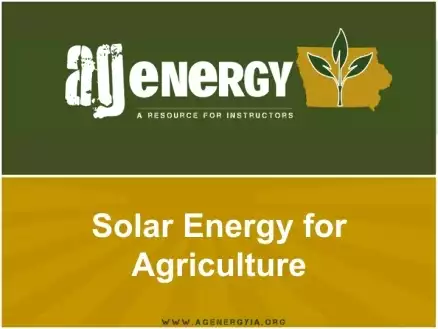Agriculture Energy - Module 6 - Solar Energy for Agriculture
Summary
- Estimated Lecture Hours: 3
- Format: PowerPoint
This is Module 6 of 15 of the Agriculture Energy Curriculum that provides non-biased material that puts students in a position to make a decision about the agricultural energy that interests them most, or is most cost effective for their own farms. User Guide is provided. This curriculum was produced by Eastern Iowa Community Colleges.
Learning Goals
Learning Objectives
-
Define solar energy and discuss its history and characteristics as a renewable energy source.
-
Distinguish between active and passive solar technologies and explain the basic processes involved with each.
-
Discuss basic components and design of solar energy systems.
-
Illustrate potential applications for solar energy in agriculture.
-
Appraise a region's solar potential and design a basic solar power system with the use of on-line project development tools.
Context for Use
Description and Teaching Materials
>> Go to Module 6
>> Energy Links and Resources
Please see the User Guidefor information on how to use this curriculum
Teaching Notes and Tips
Topics Covered
- Solar energy basics
- Active and passive solar technology
- Basic components of solar equipment
- Basic solar energy system design
- Solar applications in agriculture
- Design a basic solar power system
- Summary
Background
There is high interest among the forums in the topic of agriculture-based renewable energy technologies and the need to create jobs that meet energy demands in rural areas. In the last decade, bioscience has become one of the nation's most significant sectors in research and economic activity and grew by 4.6% across the U.S., adding close to 270,000 jobs nationally. Agriculture biotechnology products totaled less than $1 billion in 1995, but grew to $10 billion in 2005. More than 1,100 companies are engaged in Iowa's biosciences industry, employing over 72,000 highly-skilled workers. Some of the most promising biobased products are produced in immense quantities in rural areas.
This project was funded by the New Era Rural Technology Competitive Grants Program (USDA) which makes grants available to community colleges or advanced technological centers, located in a rural area, for technology development, applied research, and training necessary to produce graduates capable of strengthening the Nation's technical, scientific and professional workforce in the fields of bioenergy, pulp and paper manufacturing, and agriculture-based renewable energy resources. Although, focused on Iowa – these technologies cross all geographical regions.
Iowa and Agricultural Energy
Iowa's strengths in animal and plant sciences at its research universities and in the private sector point toward large-scale market potential and development of a bioscience sector. According to the Iowa Renewable Fuels Association, Iowa is the nation's number one ethanol-producing state and ranks second in the production of biodiesel, processing more than 400 million bushels of corn into 1.1 billion gallons of ethanol annually and producing over 25% of U.S. biodiesel production. Iowa's biofuels industries have added $8 billion to Iowa's economy, generated $2 billion in new household income, and created 50,000 Iowa jobs. Agriculture households and rural communities have responded to government incentives and have expanded their production of renewable energy, primarily in the form of biofuels and wind power.
References and Resources
>> Energy Links and Resources
Citation
(2013). Agriculture Energy - Module 6 - Solar Energy for Agriculture


![[creative commons]](/images/creativecommons_16.png)




